Intro
Discover whats in Zofran, a medication for nausea relief. Learn about its active ingredients, uses, and side effects, including ondansetron, a key component in preventing vomiting and dizziness, especially during pregnancy and chemotherapy treatments.
Zofran, also known as ondansetron, is a medication used to prevent nausea and vomiting caused by cancer chemotherapy, radiation therapy, and surgery. It belongs to a class of medications called 5-HT3 receptor antagonists, which work by blocking the action of a natural substance in the body that causes nausea and vomiting. But what exactly is in Zofran? Let's break down the ingredients and explore how they work.
The active ingredient in Zofran is ondansetron hydrochloride, which is a white, crystalline powder that is highly soluble in water. The inactive ingredients in Zofran tablets and oral solution include lactose, microcrystalline cellulose, pregelatinized starch, and other excipients. The injection form of Zofran contains ondansetron hydrochloride, sodium chloride, and citric acid.
Zofran works by blocking the action of serotonin, a natural substance in the body that can cause nausea and vomiting. When serotonin binds to 5-HT3 receptors in the vomiting center of the brain, it triggers a response that leads to nausea and vomiting. Ondansetron blocks these receptors, preventing serotonin from binding and triggering this response.
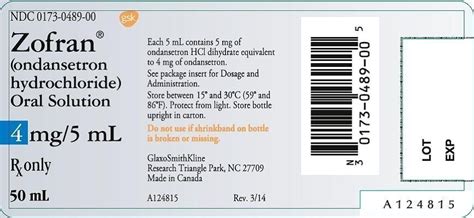
How Zofran Works
Zofran works by blocking the action of serotonin at the 5-HT3 receptors, which are located in the vomiting center of the brain and in the gut. When chemotherapy, radiation, or surgery causes the release of serotonin, it binds to these receptors, triggering a response that leads to nausea and vomiting. By blocking these receptors, ondansetron prevents serotonin from binding and triggering this response, thereby preventing nausea and vomiting.
The exact mechanism of action of Zofran is not fully understood, but it is thought to involve the blockade of serotonin at the 5-HT3 receptors in the vomiting center of the brain and in the gut. This blockade prevents the transmission of signals that would normally lead to nausea and vomiting.
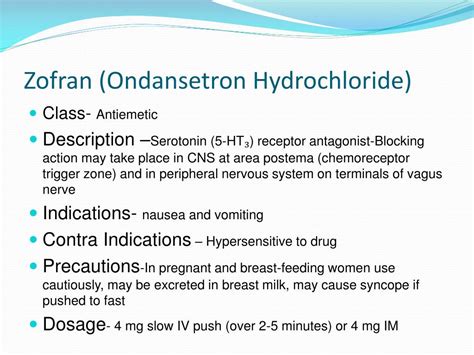
Benefits of Zofran
Zofran has several benefits that make it a popular choice for preventing nausea and vomiting. Some of the benefits of Zofran include:
- Effective prevention of nausea and vomiting: Zofran has been shown to be highly effective in preventing nausea and vomiting caused by chemotherapy, radiation, and surgery.
- Fast-acting: Zofran works quickly, with most people starting to feel relief from nausea and vomiting within 30 minutes of taking the medication.
- Long-lasting: The effects of Zofran can last for up to 24 hours, providing long-lasting relief from nausea and vomiting.
- Well-tolerated: Zofran is generally well-tolerated, with most people experiencing few side effects.

Side Effects of Zofran
Like all medications, Zofran can cause side effects. Some common side effects of Zofran include:
- Headache
- Dizziness
- Drowsiness
- Constipation
- Diarrhea
Most side effects of Zofran are mild and temporary, and they often go away on their own within a few days. However, some people may experience more serious side effects, such as:
- Allergic reactions: Some people may be allergic to Zofran, and may experience symptoms such as hives, itching, and difficulty breathing.
- QT prolongation: Zofran can cause a condition called QT prolongation, which can increase the risk of abnormal heart rhythms.
- Serotonin syndrome: Zofran can cause a condition called serotonin syndrome, which can occur when there is too much serotonin in the body.

Precautions and Warnings
Zofran can interact with other medications, and may not be suitable for everyone. Some precautions and warnings to be aware of include:
- Pregnancy and breastfeeding: Zofran should be used with caution in pregnant and breastfeeding women, as it may pass into breast milk and affect the baby.
- Children: Zofran should be used with caution in children, as it may cause side effects such as diarrhea and constipation.
- Older adults: Zofran should be used with caution in older adults, as it may cause side effects such as dizziness and drowsiness.
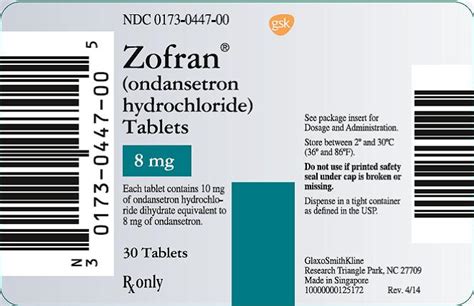
Interactions with Other Medications
Zofran can interact with other medications, including:
- Apomorphine: Zofran can increase the risk of QT prolongation when taken with apomorphine.
- Cisapride: Zofran can increase the risk of QT prolongation when taken with cisapride.
- Erythromycin: Zofran can increase the risk of QT prolongation when taken with erythromycin.
- Ketoconazole: Zofran can increase the risk of QT prolongation when taken with ketoconazole.
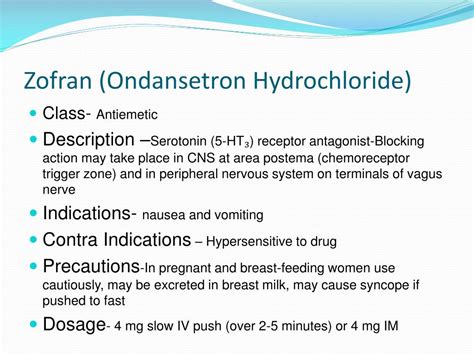
Dosage and Administration
The dosage and administration of Zofran will depend on the individual and the condition being treated. The recommended dosage of Zofran for preventing nausea and vomiting caused by chemotherapy, radiation, and surgery is:
- 8mg taken 30 minutes before chemotherapy, followed by 8mg taken 4 and 8 hours after the first dose.
- 8mg taken 1-2 hours before radiation, followed by 8mg taken 4 and 8 hours after the first dose.
- 16mg taken 1 hour before surgery.
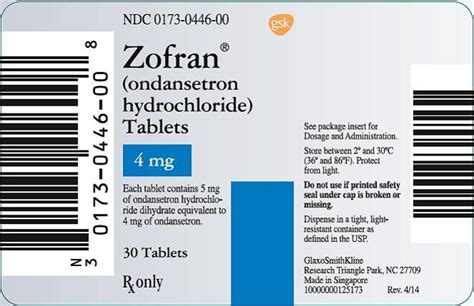
Conclusion and Final Thoughts
In conclusion, Zofran is a highly effective medication for preventing nausea and vomiting caused by chemotherapy, radiation, and surgery. It works by blocking the action of serotonin at the 5-HT3 receptors, preventing the transmission of signals that would normally lead to nausea and vomiting. While Zofran can cause side effects, it is generally well-tolerated and can provide long-lasting relief from nausea and vomiting.
If you are experiencing nausea and vomiting, talk to your doctor about Zofran. They can help you determine if Zofran is right for you and provide guidance on how to take it safely and effectively.
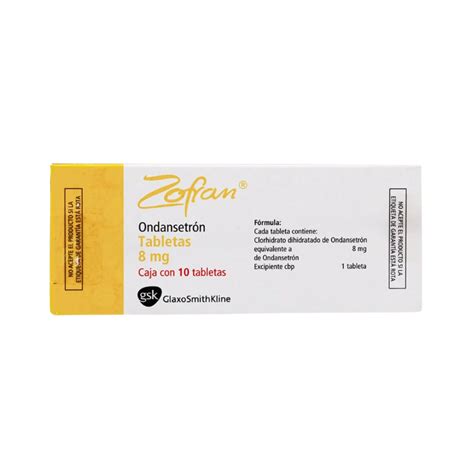
We hope this article has provided you with a comprehensive understanding of Zofran and its uses. If you have any questions or comments, please feel free to share them below. We would love to hear from you and help you in any way we can.
What is Zofran used for?
+Zofran is used to prevent nausea and vomiting caused by cancer chemotherapy, radiation therapy, and surgery.
How does Zofran work?
+Zofran works by blocking the action of serotonin at the 5-HT3 receptors, preventing the transmission of signals that would normally lead to nausea and vomiting.
What are the side effects of Zofran?
+Common side effects of Zofran include headache, dizziness, drowsiness, constipation, and diarrhea. More serious side effects can include allergic reactions, QT prolongation, and serotonin syndrome.
